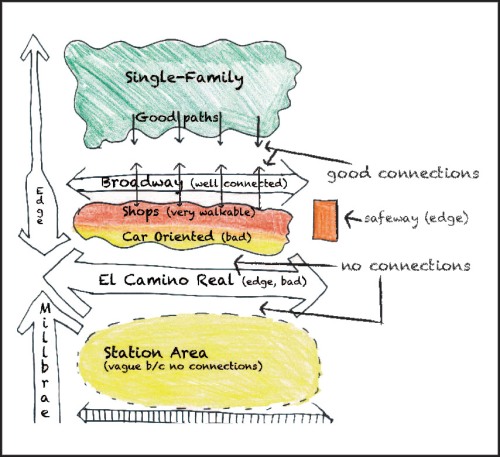In recent months the City of Millbrea, BART and two other developers (Sierra Station Properties and Republic Urban) have signed an initial agreement to develop sites on the east and west side of the station. The city has wanted to develop these sites ever since they drafted the station area plan back in 1998, but missed the boat after the 2008 crash. So I am excited that after all these years there is some movement to bring more people to the station.
Right now the station is still impossible to access on foot or by bike without endangering your life! Let’s make it safer when the new development happens.
Remember this is what we have (bad, too much traffic, dangerous):
We want connections to the station! (wonderful, super, beautiful)
Though there are no specifics with the development plans as of yet, the Station Area Plan has lots of robust ideas on how to make the station more accessible to those coming on foot and bike. Another good point is that the very old plan will be updated as part of this new process.
Peninsula Transportation Alternatives has a good post about how to get more involved. You can read it here.
Its probably a good idea to bring up my principles that should make the station more walkable.
1. Create a set of design guidelines that institutionalizes the principles listed below. Form-based codes are one way to accomplish this.
2. Designing a consistent and recognizable wayfinding signage package utilizing kiosks at critical directional decision-making locations will further encourage and guide station users. These locations would include all intersections on Broadway and the intersections of Hillcrest and Victoria at El Camino Real. This signage should be installed with only one pole and be combined with other street furniture wherever possible. It should be installed outside the active part of the sidewalk and could be located on the bulb-out if necessary.
3. Building sidewalks with a minimum width of 9 feet. Additional sidewalk width free of obstructions with a buffer of on-street parking and/or trees provides a sense of safety and comfort.
4. Painting white crosswalks spanning the signalized intersections at Hillcrest and Victoria Streets on the north, south, east, and west corners combined with refuge islands between 6-10 feet wide. Maintaining the median strip of 6-10 feet wide on ECR will provide space for pedestrian refuge islands, which will help guide and protect pedestrians and cyclists approaching the station. Instituting generous signal timing at the signalized intersections (no faster than 4 feet/second) with crosswalks encourages the user to move at a comfortable and natural pace toward their destination.
5. Installing bulb-outs at all corners of all intersections of El Camino with the buffer streets will shorten crossing distances for pedestrians.
6. Increasing the density of development along El Camino. Encourage the construction of buildings that are between 50-60 feet tall (five stories) to create a sense of place and scale. Buildings on El Camino, especially at corners, should have landmark style designs that create a strong impression from the street and sidewalk. Develop context-sensitive, mixed-use buildings along Broadway and buffer streets.
7. Installing pedestrian scale lighting on all streets fronting the wayfinding path. Include side streets if financing is available.
8. Placing street furniture such as newspaper boxes, benches, and bollards outside of the pedestrian circulation zone of the sidewalk and not closer than 2 feet from the curb. Bike racks should be provided as close to businesses as possible and parallel to the street.
9. Reducing the width of the lanes on ECR to no more than eleven feet if the six-lane configuration is maintained. If a four-lane configuration is feasible, wider traffic lanes and a bike lane could be installed. The bike lanes should be at least six feet wide and placed to the right of traffic lanes next to the curb.
10. Installing class III bike facilities (sharrows) on other selected streets in the study area. Many of the streets in Millbrae are too narrow for separated bike lanes without removing parking. Traffic speeds are slow enough to allow bikes and cars to share the roadway.
There are a ton of other posts about what’s out there now, other improvements, etc. if older posts. Take a look and I’ll try to keep this blog updated with new developments.



Pingback: Millbrae reviews development near Caltrain/BART station – can it be walkable? | Peninsula Transportation Alternatives